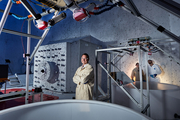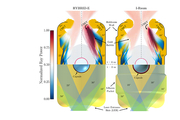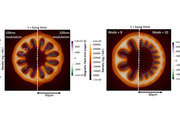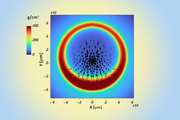Polymer Production Enclave Puts Additive Manufacturing on the Fast Track
June 9, 2022-
Since its establishment, Lawrence Livermore has played a critical role in designing components for the Nuclear Security Enterprise (NSE), and more recently, in developing additively manufactured polymer parts to replace aging weapons stockpile parts. Additive manufacturing (AM)—the layer-by-layer technique of printing 3D objects from a digital model—gained traction at Livermore in 2009 after...
Hydrodynamic Experiments Support Stockpile Stewardship
June 8, 2022-
Inside a heavily shielded chamber with 1.8-meter-thick concrete walls, high explosives detonate around a mass of inert test material. Subjected to an intense shock wave, the material briefly acts like a liquid. Advanced diagnostic equipment installed throughout the chamber captures thousands of data points and x-ray images from almost every angle in a split second. The hydrodynamic test—so...
Nature paper chronicles how researchers achieved burning plasma regime for the first time in a laboratory experiment
Jan. 26, 2022-
After decades of fusion research, a burning plasma state was achieved on November 2020 and February 2021 at Lawrence Livermore National Laboratory’s National Ignition Facility (NIF), the world’s most energetic laser.
Obtaining a burning plasma is a critical step toward self-sustaining fusion energy. A burning plasma is one in which the fusion reactions themselves are the primary source of...
Nature paper describes the target and laser designs that achieved a burning plasma at Lawrence Livermore
Jan. 26, 2022-
One of the last remaining milestones in fusion research before attaining ignition and self-sustaining energy production is creating a burning plasma. In this state, the fusion reactions themselves become the dominant source of heating in the plasma, but do not yet overcome all mechanisms of energy loss.
A burning plasma state was achieved on November 2020 and February 2021 at Lawrence...
Ironing out the interiors of exoplanets
Jan. 13, 2022-
The discovery of more than 4,500 extra-solar planets has created a need for modelling their interior structure and dynamics. As it turns out, iron plays a key role.
Lawrence Livermore National Laboratory (LLNL) scientists and collaborators have used lasers at the National Ignition Facility to experimentally determine the high-pressure melting curve and structural properties of pure iron up...
New research looks at process of magnetic flux generation in ICF implosions
Oct. 27, 2021-
Lawrence Livermore National Laboratory (LLNL) researchers now have a better understanding on how strong the magnetic fields are in an inertial confinement fusion (ICF) implosion at the National Ignition Facility (NIF), the world’s most energetic laser.
The researchers described their findings a paper published in Physics of Plasmas
with LLNL scientists Chris Walsh serving as lead author and...
Study reveals cause of 3D asymmetry in ICF implosions
Feb. 25, 2021-
Inertial confinement fusion (ICF) implosions require very high levels of symmetry in order to reach the high densities and temperatures required for fusion induced self-heating. Even percent-level deviations from perfect spherical symmetry can lead to significant distortions of the implosion and ultimately degrade fusion performance.
To that end, researchers from Lawrence Livermore...











